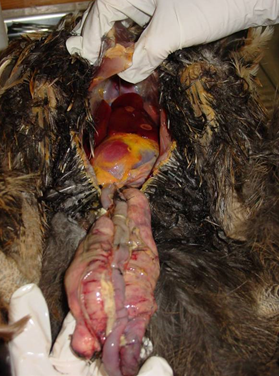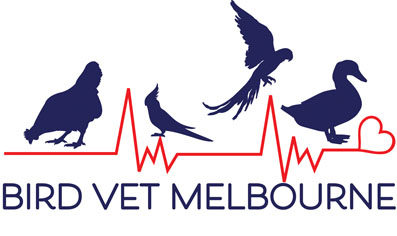Blackhead in Peacocks

Peacock Blackhead -Treatment
Blackhead (Histomoniasis) in Peacocks, Quail, Turkeys and Chickens
Blackhead (Histomoniasis) is caused by an amoeba-like parasite, Histomonas meleagridis, that lives in the caeca of chicken, turkeys, quail, pheasants and other gallinaceous (chicken-like) birds. The caeca are blind portions of the intestine, the equivalent to the human appendix, which are paired and large in gallinaceous birds.
Life Cycle
This is complicated! Histomonas is typically carried by Heterakis roundworms that also live in the caeca. Histomonas parasites are passed in Heterakis worm eggs in the droppings; the thick shell of the worm egg protects the fragile Histomonas organisms. If the eggs are ingested by another gallinaceous bird, the eggs hatch out in the caeca producing both more round worms as well as allowing the Histomonas organism to escape andmultiply and possibly cause disease.
Who is Susceptible?
Peacock, turkeys and quail (both native button quail (Turnix spp) as well as domestic quail (Coturnix spp) are typically more susceptible to Blackhead than chickens. A common scenario is that if these species are kept where they can come into contact with chicken droppings containing Histomonas contaminated Heterakis worm egg, the chickens themselves, because of their greater natural immunity, may remain well and show no signs of disease while the other species may become very ill and die.
Great care must be taken to ensure appropriate worming if chickens are kept on the same soil as turkeys, peacocks of quail. Preferably these species should be housed separately from chickens.
Blackhead Disease
Disease Histomonas is especially dangerous as when it is ingested it does not remain solely in the gastrointestinal system but can migrate first to the liver and then to other organs such as spleen, kidneys and lungs. While migrating the parasites can cause haemorrhages and severe tissue damage resulting in high mortalities. If birds survive, extensive scarring occurs which can result in secondary complications.
Diagnosis of Blackhead
Blackhead can be suspected in birds passing typical Heterakis worm eggs (identified by microscopic examination of droppings and/or a faecal flotation test) that are showing signs of illness. It needs to be differentiated from other diseases such as coccidiosis, bacterial or viral infections. A blood panel will typically show elevated liver enzymes.
Treatment of Blackhead
Treatment consists of dosing with drugs such as metronidazole, dimetronidazole or ronidazole. Instructions will vary depending on which drugs is selected and manufacturer’s recommendations. Veterinary advice should be sought as some drugs (e.g.dimetronidazole, Emtryl) can be toxic if over dosed (e.g. if birds drink excessive medicated drinking water on hot days) and care needs to be taken with administration.

What is the daily doses of metronidazole and ronidazole 20% for peafowl when treating Histomoniasis and Trichomoniasis? Also, please tell me what makes the inside of a peacock’s beak and tongue turn black.
We recommend metronidazole. The dose for metronidazole to treat histomoniasis is 25-50 mg/kg twice a day for 5 days. Fendbendazole may also be needed to treat the cecal worm Heterakis that carries the Histomoniasis organism.
I´m dealing with Peacocks that have chicks each year. The chicks die each year and are always diagnosed with Histomonas. Treatment with metronidazol as soon as symptoms start doesn´t make any difference, it just postpones death slightly.
This year I got involved and started to deworm the Peacocks every three months followed by a fecal examination 2 weeks later. In the large stable the topsoil has been replaced. In the aviary this is too hard for the owner.
My question is, do we just continue deworming until the cycle is broken? Or should we treat the entire group, including adults with Metronidazol, because direct transfer without Wormeggs is possible too and the aduklts might be carrying it? The neighbors have chicken and are appr. 100m away. Maybe wild birds or movement of worms could help spread the disease as well? Any thoughts on these remarks?
Chicks should be kept in a coop off the ground and fed a medicated starter crumble for the first 4 months to avoid any Coccidiosis infection. It takes 3 months for a peachick’s immune system to develop its resistance. It will take 4 months to develop a resistance to Blackhead. Worming is part of the Blackhead treatment as the Blackhead protozoan (histomonas) is a parasite to the Cecal worm that attacks the liver. It is a good practice to clean up a flock before the beginning of the laying season and at the end of it with the All in One available from pigeon supply outlets. It will worm your birds plus clean out any Coccidiosis and Blackhead your flock may have. Give the treatment and repeat it in 10 to 12 days after the end of the first round. Acute cases in a grown peacock should be treated with one or two 250mg tablets of metronidazole daily for 10 days or until the yellow goes out of the poop. Yellow poop is a classic sign of acute Blackhead. It is bile from a damaged liver infected with the Blackhead protozoans. Join our group: Peacocks Only